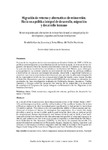
Please use this identifier to cite or link to this item:
http://ricaxcan.uaz.edu.mx/jspui/handle/20.500.11845/258Full metadata record
| DC Field | Value | Language |
|---|---|---|
| dc.contributor | 15139 | - |
| dc.contributor.other | https://orcid.org/0000-0002-0685-3165 | - |
| dc.coverage.spatial | México | es_ES |
| dc.creator | García Zamora, Rodolfo | - |
| dc.creator | Del Valle, Rosa Elena | - |
| dc.date.accessioned | 2017-05-24T16:55:25Z | - |
| dc.date.available | 2017-05-24T16:55:25Z | - |
| dc.date.issued | 2016-01 | - |
| dc.identifier | info:eu-repo/semantics/publishedVersion | - |
| dc.identifier.issn | 2448-7155 | es_ES |
| dc.identifier.uri | http://hdl.handle.net/20.500.11845/258 | - |
| dc.identifier.uri | https://doi.org/10.48779/amcx-am63 | - |
| dc.description | As a result of the repercussions from the economic crisis in the United States (2007- 14), anti-immigrant policies and the militarization of the northern border, the return of Mexican migrants to their homeland grew significantly in that period to more than 2.5-million people. This return calls into question the ability of the economic and institutional structures of Mexico to reintegrate that population. As a result, this study identifies a need to reorient public policies and integrate them into an integral policy for employment, human development and human security, and to build a new institutional architecture that allows for the adequate integration of returned migrants to Mexico and underscores the structural causes of migration, as identified by the Migrations Collective for the Americas (COMPA). In this work, we present the results of a research initiative carried out in Michoacán, Oaxaca, Zacatecas, Puebla, Guerrero and Chiapas on the impacts of return migration and the need to establish the Program for Support and Integral Re-insertion of Migrants and their Families (Parimyf). | es_ES |
| dc.description.abstract | A causa de los impactos de la crisis económica en Estados Unidos de 2007 a 2014, las políticas antiinmigrantes y la militarización de la frontera norte, el retorno de los migrantes mexicanos crece de manera considerable a más de 2.5 millones de personas. Lo que cuestiona la estructura económica e institucional de México para reintegrar a esa población. Lo anterior plantea la necesidad de reorientar las políticas públicas e instituirlas en una que sea integral de empleo, desarrollo y seguridad humanos, y construir una nueva arquitectura institucional que permita la adecuada integración de los migrantes e incidir en las causas estructurales del éxodo, como la que plantea el Colectivo Migraciones para las Américas (COMPA). En este trabajo se presentan los resultados de una investigación realizada en Michoacán, Oaxaca, Zacatecas, Puebla, Guerrero y Chiapas sobre los impactos del retorno de los migrantes y la necesidad de establecer el Programa de Apoyo Integral a la Reinserción de los Migrantes y sus Familias (Parimyf). | es_ES |
| dc.language.iso | spa | es_ES |
| dc.publisher | Universidad Autónoma del Estado de México | es_ES |
| dc.relation | http://revistahuellasdelamigracion.blogspot.mx/search/label/N%C3%BAmeros%20anteriores | es_ES |
| dc.relation.uri | generalPublic | es_ES |
| dc.rights | Attribution-NonCommercial-ShareAlike 3.0 United States | es_ES |
| dc.rights.uri | http://creativecommons.org/licenses/by-nc-sa/3.0/us/ | * |
| dc.source | Huellas de la Migración vol. 1 núm. 1 enero-junio 2016, 182-220 | es_ES |
| dc.subject.classification | CIENCIAS SOCIALES [5] | es_ES |
| dc.subject.other | info:eu-repo/classification/Crisis económica | - |
| dc.subject.other | info:eu-repo/classification/Migración de retorno | - |
| dc.subject.other | info:eu-repo/classification/Desarrollo humano - Políticas | - |
| dc.title | Migración de retorno y alternativas de reinserción. Hacia una política integral de desarrollo, migración y desarrollo humano | es_ES |
| dc.type | article | es_ES |
| Appears in Collections: | *Documentos Académicos*-- UA Estudios del Desarrollo | |
Files in This Item:
| File | Description | Size | Format | |
|---|---|---|---|---|
| Garcia, Del Valle. Migración de retorno y alternativas.pdf | Versión publicada | 3,47 MB | Adobe PDF |  View/Open |
This item is licensed under a Creative Commons License
